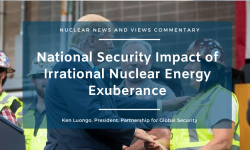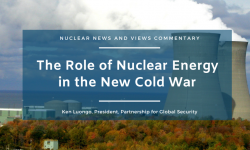It has been clear for some time that China is angling to become the Amazon.com of nuclear commerce in the 21 st Century and a key part of its approach is nuclear reactor exports under its Belt and Road Initiative. This reality was highlighted by the head of China’s National Nuclear Corporation (CNNC) at a recent nuclear summit. The Chinese-designed reactors for export span current light-water technology through next-generation advanced reactors.
China is pursuing a three-pronged strategy.
First, there is its own significant nuclear building program, that will make it the largest nuclear fleet operator by mid-century. At present, China accounts for about one-fifth of nuclear capacity under construction around the world.
Second, it is engaged with the U.K.’s regulatory authorities on its indigenous Hualong One reactor design. If approved, there is the potential to build and operate one and perhaps several of these reactors in the U.K., thereby proving its operational capability in a high regulation country and strengthening its export appeal.
Third, through its One Belt, One Road Initiative and Made in China 2025 programs, China is seeking to dominate advanced nuclear technology in the developing world. A high-temperature gas-cooled reactor is already under construction in China and it has committed $3.3 billion to a molten salt reactor test bed in the Gobi Desert.
China may also copy Russia’s successful foreign sales playbook and offer to finance, build, operate, supply fuel, and take back the spent fuel from its exported reactors. This is a potentially potent challenge to Russia’s current domination of the international reactor market because China has considerably more money available to lend to purchasers. China also could ratchet up the competition with Russia if it builds an industrial scale spent fuel reprocessing plant.
China’s President Xi and France’s President Macron met at the end of March to further discussions on potential cooperation on the reprocessing plant. There is a long-standing civil nuclear relationship between France and China dating back to the early 1990s. While this plant could be used to manage China’s own considerable spent fuel it also could reprocess spent reactor fuel from its exported reactors. That raises an important question about which country would own and have access to the separated plutonium produced from the fuel treatment process. The resulting “reactor grade” plutonium has been proven to be useable in a nuclear explosive.
This plutonium separation issue could be important in the volatile Middle East if Saudi Arabia chooses China as its supplier for the two reactors it plans to build. There is also a strong relationship link between Saudi Arabia, Pakistan, and China that raises uranium enrichment questions.
The U.S., Russia, France, and South Korea are the other competitors for the Saudi’s business. But, the U.S. Congress has taken a number of actions to thwart the sale of U.S. technology in part because of legitimate weapons proliferation concerns, anger about Saudi actions, and suspicion of the Trump administration’s handling of the negotiations.
But it is important to realize that the default alternative to America’s technology is not South Korea’s. Almost certainly South Korea would not be able to export the reactors it is currently building in the UAE without a U.S.-Saudi 123 nuclear cooperation agreement that would pave the way for U.S. technology export. There is significant U.S. technology in the Korean reactors. Without an agreement and its Congressional approval, France, China and Russia are the best-positioned bidders for the Saudi’s business.
The geopolitics of the global export nuclear market is shifting, and new dangers are emerging that may not be adequately apparent to, or appreciated by, nuclear experts and policymakers. Russia is dominant now, but China is making all the moves that are required to unseat it. Both nations’ nuclear industries are state-controlled and fully integrated into their geostrategic objectives.
The U.S. is not in a strong position to stand alone in the nuclear market. Its industrial base has atrophied, its political institutions are divided and distrustful, and its export financing is in shambles. It can take actions to fix these flaws and it can partner with one or more close allies on sales opportunities. However, a decision – through intention or indifference - to fade away from the nuclear export arena will have consequences for the intensifying great power rivalry, the ability to win the vital global technology competition, and the future strength of global nuclear non-proliferation and security.





